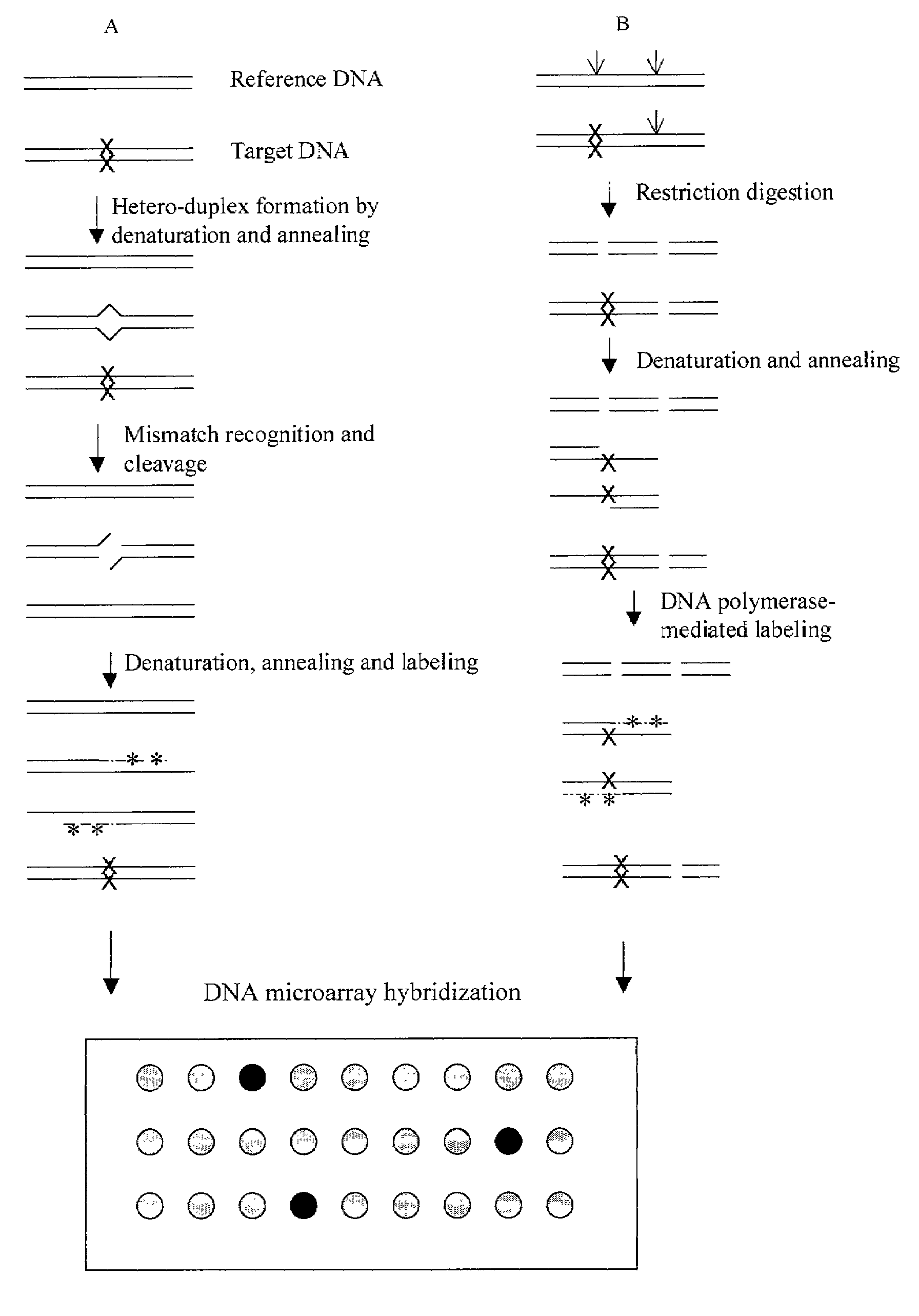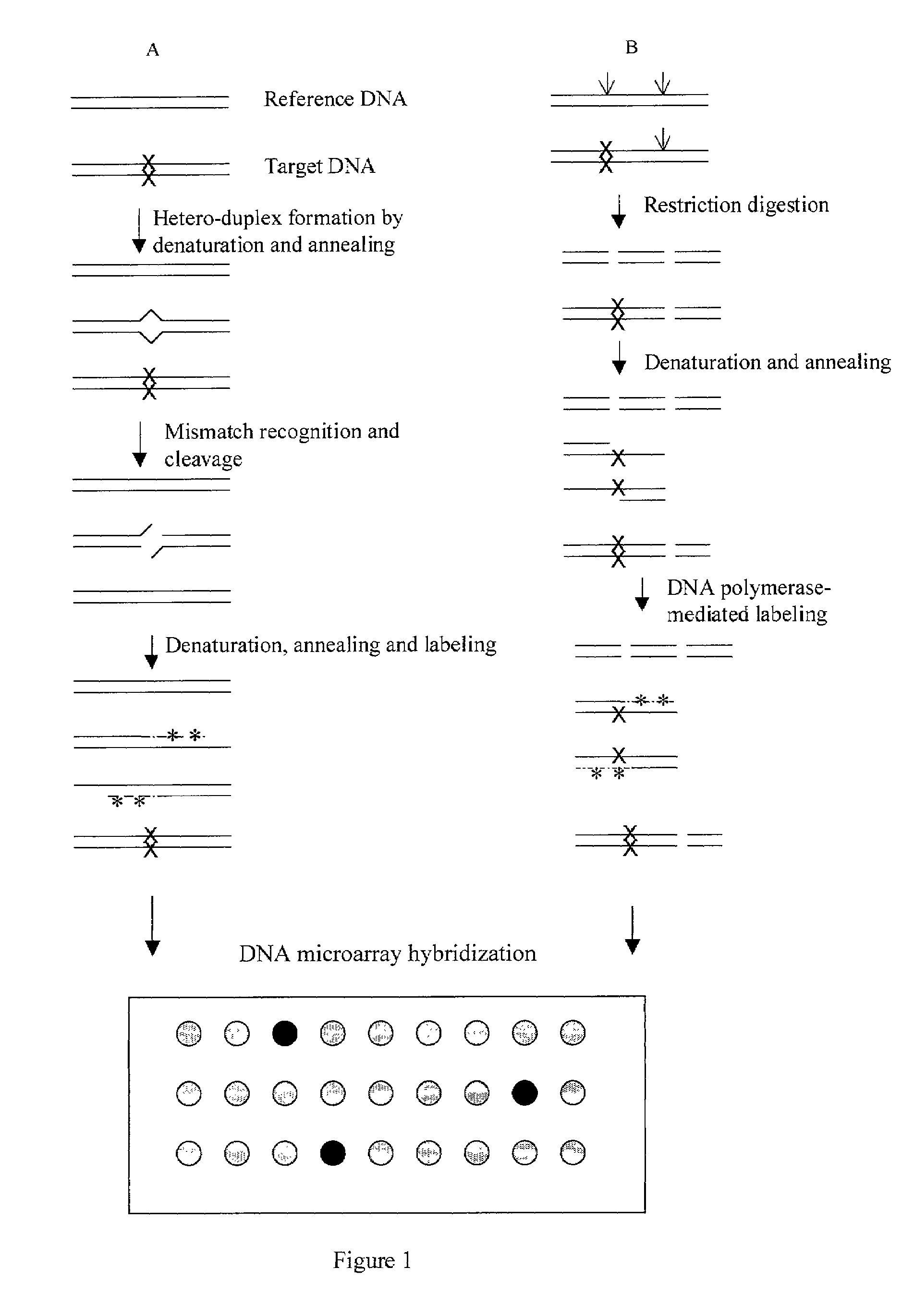Methods for detecting and localizing DNA mutations by microarray
a microarray and dna technology, applied in the field of methods for detecting and localizing dna mutations by microarray, can solve the problems that none of the known methods can efficiently detect and define the location of mutations at a genomic level, and achieve the effect of reducing the effect of non-specific cutting or digestion
- Summary
- Abstract
- Description
- Claims
- Application Information
AI Technical Summary
Benefits of technology
Problems solved by technology
Method used
Image
Examples
example 1
Detection and Localization of DNA Mutations by the RE Mutation Detection Microarray Method.
[0023]Restriction fragment length polymorphism (RFLP) is one of the most popularly used methods for mutation detection and sequence comparison. However, it can not define the location of the mutation. In this experiment, a microarray method is developed for rapid detection and localization of DNA mutations.
[0024]A mutation in a mutant plasmid pLG125 caused the missing of an Ase I site, which is present in the wild type plasmid pKH28 (see Materials and FIG. 2).
[0025]One microgram (μg) of pLG125 and pKH28 were double digested with Pvu II and Ase I in NEB buffer 2 plus BSA, purified with QIAquick PCR purification kit and resuspended in 30 microliter (μI) of EB buffer (10 mM Tris-HCL, pH8.0). 5 μl of the above digested pKH28 DNA was mixed with 5 μl of the above pLG125 DNA to give a heteromixture DNA. 10 μl of the above digested pKH28 was also taken and called a control DNA. To label the DNA, the f...
example 2
Detection and Localization of DNA Mutations by the MR Mutation Detection Microarray Method.
[0026]This experiment composes of four major steps: formation of heteroduplex and homoduplex DNA; treatment of the duplexes with a mismatch-recognition endonuclease to cleave the heteroduplexes at the mismatch site; labeling the cleaved DNA by DNA polymerase-mediated incorporation of modified nucleotides; and hybridizing the labeled DNA to DNA microarray.
[0027]There are a few mismatch-recognition endonucleases such as SP nuclease and Mung Ben nuclease. Here, Cel I nuclease was chosen to use because of its high specificity of cleavage at all single nucleotide substitutions (Oleykowski et al (1998) Nucleic Acids Research 26: 4597).
[0028]To detect and localize a mutation in plasmid pLG119, both pLG119 and wild-type plasmid pKH28 were digested with Sca I and then purified with QIAquick PCR purification kit. One microgram of this Sca I-digested pLG119 (pLG119 / Sca I) was mixed with one microgram of ...
PUM
| Property | Measurement | Unit |
|---|---|---|
| final volume | aaaaa | aaaaa |
| final volume | aaaaa | aaaaa |
| fluorescent | aaaaa | aaaaa |
Abstract
Description
Claims
Application Information
 Login to View More
Login to View More - R&D
- Intellectual Property
- Life Sciences
- Materials
- Tech Scout
- Unparalleled Data Quality
- Higher Quality Content
- 60% Fewer Hallucinations
Browse by: Latest US Patents, China's latest patents, Technical Efficacy Thesaurus, Application Domain, Technology Topic, Popular Technical Reports.
© 2025 PatSnap. All rights reserved.Legal|Privacy policy|Modern Slavery Act Transparency Statement|Sitemap|About US| Contact US: help@patsnap.com



